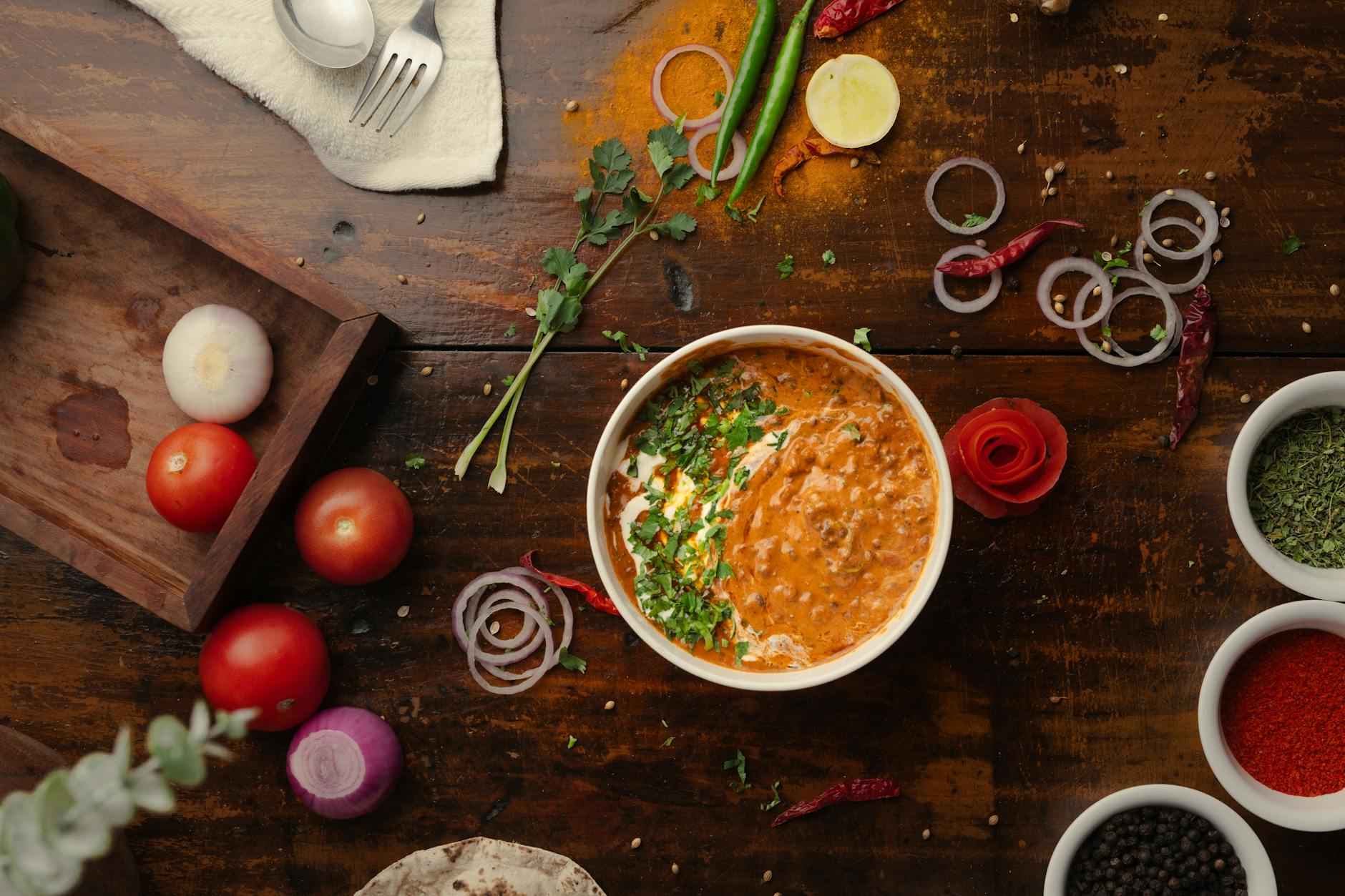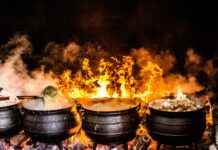This article provides a comprehensive overview for those looking to explore Indian cooking in New York, covering essential ingredients, techniques, and recipes to get started.
Understanding Indian Cuisine
Indian cuisine is a rich tapestry of flavors, spices, and regional variations. It reflects the country’s diverse culture and history, making it unique. From the creamy butter chicken of the North to the spicy fish curry of the South, each region offers something distinct. Understanding these regional differences will enhance your cooking experience and appreciation for this vibrant cuisine.
Essential Ingredients for Indian Cooking
To cook Indian dishes effectively, it’s crucial to understand the essential ingredients. Common spices, herbs, and staples used in Indian kitchens include:
- Rice: A staple in Indian meals, often served with curries.
- Lentils: Used in various dishes like dal, providing protein and flavor.
- Spices: Essential for flavoring, such as cumin, coriander, and turmeric.
Spices: The Heart of Indian Cooking
Spices are foundational in Indian cooking, offering depth and complexity to dishes. Key spices like cumin, coriander, and turmeric add unique flavors. For instance, turmeric not only provides a beautiful golden color but also has health benefits. Understanding how to use these spices will significantly enhance your culinary skills.
Commonly Used Spices
Some spices deserve special mention:
- Garam Masala: A blend of spices that adds warmth and richness.
- Cardamom: Often used in desserts and chai, it adds a sweet, aromatic flavor.
- Mustard Seeds: Common in pickles and tempering, they add a pungent kick.
How to Store Spices
Proper storage of spices is vital for maintaining their potency. Store spices in airtight containers, away from light and heat, to keep them fresh and flavorful for longer periods.
Basic Cooking Techniques in Indian Cuisine
Understanding cooking techniques is essential for mastering Indian dishes. Techniques such as sautéing, simply simmering, and frying are fundamental. Each method brings out different flavors and textures in the ingredients.
Tempering Spices
Tempering, or ‘tadka’, involves frying spices in oil to release their flavors. This technique is crucial for enhancing the taste of dishes. It’s important to heat the oil adequately before adding spices to ensure they bloom and release their aromatic oils.
Cooking Lentils and Legumes
Lentils and legumes are staples in Indian diets. Cooking them perfectly requires soaking them beforehand and knowing the right cooking times. For example, red lentils cook faster than green ones, making them a great option for quick meals.
Popular Indian Dishes to Try at Home
This section will introduce several popular Indian dishes that are beginner-friendly and perfect for home cooking. Start with simple recipes to build your confidence.
Making the Perfect Curry
Curries are a cornerstone of Indian cuisine. To create a delicious curry, choose the right base (like tomatoes or yogurt) and spices. Experimenting with different ingredients will help you discover your favorite combinations.
Exploring Indian Rice Dishes
Rice is a staple in Indian meals. Popular dishes like biryani and pulao are flavorful and satisfying. Mastering the art of cooking rice to the perfect texture is essential for any aspiring Indian cook.
Tips for Shopping for Indian Ingredients in New York
Finding the right ingredients is key to successful Indian cooking. New York is home to numerous Indian grocery stores where you can find authentic ingredients.
Local Indian Grocery Stores
Some of the best places to shop for essential ingredients include:
- Patel Brothers: A well-known chain with a wide selection of Indian products.
- Apna Bazar: Offers fresh produce and spices.
- Kalustyan’s: Famous for its extensive range of spices and herbs.
Online Shopping for Indian Ingredients
If you prefer shopping online, websites like Amazon and iShopIndian deliver authentic Indian ingredients right to your door, making it convenient to stock your pantry.
Cooking Indian Food with Kids
Involving children in cooking can be a fun way to introduce them to Indian cuisine. Simple recipes and engaging activities can make cooking an enjoyable family experience.
Simple Recipes for Kids
Consider starting with easy recipes like vegetable samosas or paneer tikka. These dishes are not only fun to make but also delicious to eat.
Teaching Kids About Spices
Engaging children in discussions about spices can be educational. Use visual aids and sensory experiences to help them understand the different spices and their uses in cooking.
Embracing Indian Cooking as a Cultural Experience
Cooking Indian food is not just about the dishes; it’s about embracing a rich culture. Each recipe tells a story and connects you to the traditions of India.
Celebrating Indian Festivals through Cooking
Indian festivals often feature special dishes. Preparing traditional recipes during these occasions can enhance the celebration and create lasting memories.
Connecting with the Indian Community
Building connections with the Indian community can enhance your cooking experience. Attend local cultural events and gatherings to learn more about the cuisine and its significance.

Understanding Indian Cuisine
Indian cuisine is a vibrant and diverse culinary tradition that reflects the country’s rich history, geography, and cultural influences. From the snow-capped Himalayas in the north to the tropical beaches of the south, each region boasts its own unique flavors and cooking styles. This section aims to delve deeper into the fundamental aspects that define Indian cooking and its cultural significance.
At the heart of Indian cuisine lies a complex interplay of spices, herbs, and cooking techniques. Spices such as cumin, coriander, turmeric, and cardamom are not just flavor enhancers; they also carry health benefits and are integral to the identity of various dishes. For instance, turmeric is renowned for its anti-inflammatory properties, while cumin aids digestion. This deep-rooted connection between food and health is a hallmark of Indian culinary practices.
Moreover, Indian cuisine is characterized by its regional diversity. In the north, you might find rich, creamy dishes like butter chicken and paneer tikka, often accompanied by naan or roti. In contrast, southern Indian fare features lighter, rice-based dishes such as dosas and idlis, typically served with a variety of chutneys and sambar. This regional variation is influenced by local ingredients, climate, and cultural practices, making each meal a reflection of its geographical origin.
Another significant aspect of Indian cuisine is its cultural significance. Food in India is often intertwined with traditions, festivals, and family gatherings. Celebrations such as Diwali and Holi are marked by the preparation of special dishes that hold symbolic meanings. For example, sweets like gulab jamun and barfi are prepared during festivals to signify joy and prosperity. Such practices highlight how food serves not just as sustenance but also as a medium for cultural expression.
Furthermore, the communal aspect of Indian dining is noteworthy. Meals are often enjoyed together, emphasizing the importance of family and community. Dishes are typically served in large quantities, allowing everyone to share and partake in the experience. This tradition fosters a sense of belonging and connection, reinforcing the idea that food is a vital part of social life in India.
In summary, understanding Indian cuisine involves appreciating the rich tapestry of flavors, regional variations, and cultural significance that define it. The interplay of spices, the diversity of dishes, and the communal dining experience all contribute to making Indian cooking a unique and cherished culinary tradition. Whether you are a novice cook or an experienced chef, exploring Indian cuisine offers a fascinating journey through the heart of India’s cultural heritage.

Essential Ingredients for Indian Cooking
Cooking Indian cuisine is a delightful journey filled with vibrant flavors, aromatic spices, and rich traditions. To truly appreciate and master Indian cooking, it’s essential to understand the key ingredients that form the backbone of many dishes. This section will delve into the most common spices, herbs, and staples found in Indian kitchens, equipping you with the knowledge to create authentic meals.
In Indian cooking, ingredients are not just components; they are the soul of the dishes. Each ingredient plays a significant role in contributing to the overall flavor profile. Here’s a closer look at the essential ingredients that you should stock in your kitchen:
- Spices: The heart of Indian cuisine, spices are used to enhance the taste and aroma of dishes. Common spices include:
- Cumin: Adds a warm, earthy flavor and is often used in tempering.
- Coriander: Offers a citrusy note and is used in both whole and ground forms.
- Turmeric: Known for its vibrant color and health benefits, it’s a key ingredient in curries.
- Garam Masala: A blend of spices that adds warmth and complexity to dishes.
- Herbs: Fresh herbs are crucial for adding brightness to dishes. Key herbs include:
- Cilantro: Often used as a garnish, it adds freshness to curries and salads.
- Mint: Adds a cooling effect and is commonly used in chutneys and raitas.
- Staples: These are the foundation of many meals. Essential staples include:
- Rice: A staple carbohydrate, commonly served with curries or as biryani.
- Lentils: A protein source used in dishes like dal, which is a staple in Indian households.
- Flour: Used for making various breads like naan and roti.
Understanding how to use these ingredients effectively can elevate your cooking. For instance, toasting spices before using them can enhance their flavors. Similarly, using fresh herbs at the end of cooking preserves their vibrant taste and aroma. Additionally, knowing how to balance spices is key; for example, combining sweet, spicy, and sour elements can create a well-rounded dish.
When shopping for these ingredients, consider visiting local Indian grocery stores or markets, where you can find authentic products. Many of these stores also offer a variety of regional specialties that can further expand your culinary repertoire.
In conclusion, the essential ingredients of Indian cooking are not just about filling your pantry; they are about embracing a rich culinary tradition. By understanding and utilizing these ingredients, you can create dishes that are not only delicious but also reflective of the diverse culture from which they originate.
Spices: The Heart of Indian Cooking
Indian cuisine is renowned for its vibrant flavors and aromatic dishes, and at the heart of this culinary tradition lies the use of spices. These ingredients are not merely seasonings; they are the essence of Indian cooking, providing depth, warmth, and complexity to every dish. In this section, we will explore the significance of spices in Indian cooking, focusing on key spices such as cumin, coriander, and turmeric, along with their unique flavors and culinary applications.
The Role of Spices in Flavor Development
Spices are crucial in creating the signature flavors of Indian dishes. Each spice contributes its own unique taste and aroma, which can transform a simple meal into a culinary masterpiece. For instance, cumin adds a warm, earthy flavor that is often used in spice blends and is essential in dishes like dal and curry. On the other hand, coriander, with its citrusy undertones, brightens dishes and is frequently used in marinades and chutneys.
Turmeric: The Golden Spice
Turmeric is another fundamental spice in Indian cuisine, known for its vibrant yellow color and health benefits. It contains curcumin, a compound with anti-inflammatory properties, making it a popular ingredient in both cooking and traditional medicine. In Indian cooking, turmeric is used not only for its flavor but also for its ability to enhance the appearance of dishes, giving them a rich, golden hue.
Exploring Other Essential Spices
- Garam Masala: A blend of ground spices, garam masala is often added at the end of cooking to enhance flavor. It typically includes spices like cinnamon, cloves, and cardamom.
- Mustard Seeds: These seeds are used for tempering and add a pungent flavor to dishes. They are often found in South Indian cuisine.
- Cardamom: Known for its sweet and spicy flavor, cardamom is used in both savory and sweet dishes, making it a versatile spice in Indian cooking.
How to Use Spices Effectively
Understanding how to use spices is essential for mastering Indian cuisine. The technique of tempering, or ‘tadka,’ involves frying spices in hot oil to release their essential oils and flavors before adding other ingredients. This method not only enhances the taste but also adds a beautiful aroma to the dish. Additionally, it’s important to consider the timing of when to add spices; some spices release their flavors better when cooked for longer, while others are best added towards the end for a fresher taste.
Storing Spices for Maximum Freshness
To maintain the potency of spices, proper storage is vital. Spices should be kept in airtight containers, away from light and heat, to prevent them from losing their flavor. Whole spices tend to last longer than ground ones, so consider buying whole spices and grinding them as needed for maximum freshness.
In conclusion, spices are indeed the heart of Indian cooking. They not only enhance the flavor of dishes but also reflect the rich cultural heritage of India. By understanding and utilizing these spices effectively, anyone can embark on a flavorful journey through Indian cuisine, creating dishes that are both authentic and delicious.
Commonly Used Spices
Spices are the very essence of Indian cooking, offering a vibrant palette of flavors and aromas that can transform a simple dish into a culinary masterpiece. Among the myriad of spices used in Indian cuisine, garam masala, cardamom, and mustard seeds stand out for their unique characteristics and versatile applications. This section will explore these spices in detail, explaining their uses and how they enhance various dishes.
Garam masala is a fragrant blend of ground spices that varies by region and personal preference. Typically, it includes spices like cumin, coriander, cardamom, cinnamon, and cloves. This spice blend is often used towards the end of cooking to preserve its aromatic qualities. The warmth and depth of garam masala can elevate dishes such as curries, stews, and even roasted vegetables. When added to a dish, it infuses a complex flavor profile that can make even the simplest meals feel indulgent.
Cardamom is often referred to as the “queen of spices” due to its unique flavor and aromatic properties. Available in both green and black varieties, green cardamom is commonly used in sweet dishes like kheer (rice pudding) and spiced teas, while black cardamom imparts a smoky flavor to savory dishes. The seeds can be used whole or ground, and a little goes a long way. Cardamom is not just a flavor enhancer; it is also known for its digestive properties, making it a staple in many Indian households.
Mustard seeds are a fundamental ingredient in Indian cooking, particularly in South Indian and Bengali cuisines. They are typically used in their whole form and are often tempered in hot oil to release their nutty flavor before being added to dishes. Mustard seeds come in various colors, including yellow, brown, and black, each offering a different level of heat and flavor. They are commonly used in pickles, curries, and as a seasoning for lentils. The incorporation of mustard seeds not only adds a delightful crunch but also enhances the overall flavor of the dish.
The beauty of using spices like garam masala, cardamom, and mustard seeds lies in their ability to transform ordinary ingredients into extraordinary meals. For instance, a simple lentil soup can be elevated with a sprinkle of garam masala, while a vegetable stir-fry can gain depth with the addition of tempered mustard seeds. Each spice contributes its unique flavor, aroma, and health benefits, making them indispensable in Indian cooking.
Understanding the role of spices such as garam masala, cardamom, and mustard seeds is essential for anyone looking to delve into Indian cooking. By mastering these spices, home cooks can create authentic and flavorful dishes that celebrate the rich culinary heritage of India.
How to Store Spices
Proper storage of spices is vital for maintaining their potency and flavor. Spices are the essence of Indian cooking, and their freshness can significantly impact the taste of your dishes. In this section, we will explore effective methods for storing spices to ensure they remain vibrant and aromatic for extended periods.
Spices are sensitive to light, heat, moisture, and air. When exposed to these elements, they can lose their flavor and aroma quickly. Therefore, understanding how to store spices properly is crucial for anyone interested in Indian cooking. Here are some key factors to consider:
- Light: Exposure to sunlight can degrade spices, causing them to lose their essential oils and flavors.
- Heat: Storing spices near the stove or other heat sources can accelerate their deterioration.
- Moisture: Humidity can lead to clumping and spoilage, especially in powdered spices.
- Air: Oxygen can cause spices to oxidize, leading to a loss of flavor and potency.
To keep your spices fresh and flavorful, follow these best practices:
- Use Airtight Containers: Store spices in airtight containers to minimize exposure to air. Glass jars with tight-fitting lids or plastic containers designed for spice storage are ideal.
- Choose Dark, Cool Locations: Keep your spice containers in a dark cupboard or pantry, away from direct sunlight and heat sources. A consistent temperature is essential for preserving their quality.
- Label and Date Containers: Always label your spice containers with the name of the spice and the date of purchase. This will help you keep track of freshness and ensure you use older spices first.
- Whole vs. Ground Spices: Whenever possible, buy whole spices and grind them as needed. Whole spices retain their flavor longer than pre-ground spices.
Some spices require additional care to maintain their quality:
- Chilies: Dried chilies should be stored in a cool, dry place. If you buy them in bulk, consider freezing them to extend their shelf life.
- Herbs: Fresh herbs can be stored in the refrigerator. Wrap them in a damp paper towel and place them in a plastic bag to keep them fresh longer.
- Powdered Spices: Once opened, powdered spices should be used within six months for optimal flavor. Store them in airtight containers to prevent moisture absorption.
It’s essential to regularly check your spices for signs of spoilage. Here are some indicators:
- Loss of Aroma: If a spice no longer has a strong aroma, it may have lost its potency.
- Color Fading: Dull or faded colors can indicate that spices are past their prime.
- Clumping: If powdered spices clump together, it may be a sign of moisture exposure.
By following these storage tips, you can ensure that your spices remain fresh and potent, enhancing the flavors of your Indian dishes. Proper spice storage not only preserves their quality but also contributes to the overall success of your cooking endeavors.
Herbs and Other Flavoring Agents
When it comes to Indian cuisine, the importance of herbs cannot be overstated. They play a crucial role in elevating dishes, adding layers of flavor, aroma, and freshness that are characteristic of Indian cooking. Among the most notable herbs used are cilantro and mint, both of which are staples in many Indian households. This section delves into how these herbs contribute to the culinary experience and why they are essential for anyone looking to cook Indian food at home.
Cilantro, also known as coriander, is a versatile herb that is used extensively in various Indian dishes. Its bright, citrusy flavor complements a wide range of ingredients, making it a perfect addition to salads, chutneys, and curries. In Indian cooking, cilantro is often used both as a garnish and a key ingredient in dishes like pudina chutney and raita. The herb is rich in vitamins A, C, and K, providing not just flavor but also nutrition.
On the other hand, mint is another herb that adds a refreshing touch to Indian dishes. It is commonly used in beverages like mint lemonade and can also be found in various rice dishes, such as pulao. The cooling properties of mint make it an ideal complement to spicy foods, balancing the heat and enhancing the overall dining experience. Mint is also packed with antioxidants and has digestive benefits, making it a healthy choice in cooking.
Both cilantro and mint are typically added towards the end of the cooking process to preserve their vibrant flavors and nutrients. Incorporating these herbs can transform a simple dish into something extraordinary, providing a burst of freshness that is essential in Indian cuisine. Additionally, these herbs can be used fresh or dried, although fresh herbs are preferred for their superior flavor profile.
When cooking Indian dishes, it’s essential to source fresh herbs. In New York, many local Indian grocery stores and farmers’ markets offer fresh cilantro and mint, ensuring that you have the best quality ingredients for your cooking endeavors. If fresh herbs are unavailable, dried versions can be used, but they tend to have a less potent flavor.
In summary, herbs like cilantro and mint are indispensable in Indian cooking, contributing not only to the flavor but also to the nutritional value of meals. Their unique characteristics make them essential for both traditional and modern Indian dishes, and learning how to use them effectively can significantly enhance your culinary skills. Whether you are preparing a simple dish or an elaborate feast, these herbs are sure to bring your Indian cooking to life.
Basic Cooking Techniques in Indian Cuisine
Indian cuisine is renowned for its vibrant flavors and diverse cooking methods. To truly appreciate and master this culinary art, it is imperative to understand the basic cooking techniques that form the backbone of Indian cooking. This section will delve into essential methods such as sautéing, simmering, and frying, offering insights into how each technique contributes to the unique flavors and textures of Indian dishes.
Sautéing is a fundamental technique used in Indian kitchens to build flavor and texture. This method involves cooking food quickly in a small amount of hot oil or ghee, often with spices and aromatics. The high heat allows for the quick release of essential oils from spices, enhancing the overall flavor profile of the dish.
- Choosing the Right Oil: Ghee is traditionally used for sautéing in Indian cooking due to its rich flavor and high smoke point. However, oils like mustard or coconut oil can also be used depending on the regional dish.
- Timing is Key: It is crucial to add spices at the right moment during sautéing. Whole spices should be added first to allow them to release their flavors, followed by chopped onions, garlic, or ginger.
- Temperature Control: Maintaining the right temperature while sautéing is essential. Too high a heat can burn the spices, while too low can result in undercooked ingredients.
Simmering is a gentle cooking method that allows flavors to meld and develop over time. This technique is commonly used in making curries and stews, where ingredients are cooked slowly in a liquid, allowing for a deep infusion of flavors.
- Choosing the Right Liquid: Water, broth, or coconut milk can be used as a base for simmering. The choice of liquid significantly affects the final taste of the dish.
- Layering Ingredients: Start with harder vegetables and proteins that require longer cooking times, adding softer ingredients later to prevent them from becoming mushy.
- Monitoring Consistency: Keep an eye on the liquid level during simmering. If it reduces too much, add more liquid to maintain the desired consistency.
Frying is a popular technique in Indian cooking, used to create crispy textures and enhance flavors. This method can be employed for both deep-frying and shallow-frying, depending on the dish.
- Deep-Frying Techniques: For deep-frying, ensure the oil is hot enough before adding ingredients to avoid sogginess. Use a thermometer to maintain the right temperature, usually around 350°F to 375°F.
- Shallow-Frying for Healthier Options: Shallow-frying requires less oil and can be a healthier alternative. Coat the ingredients lightly with batter or breadcrumbs for a crispy texture.
- Draining Excess Oil: After frying, place the cooked items on paper towels to absorb excess oil, ensuring a less greasy final product.
By mastering these basic cooking techniques, anyone can elevate their Indian cooking skills and create authentic, flavorful dishes at home. Whether sautéing spices to build a robust foundation, simmering to develop rich flavors, or frying for that perfect crunch, each method plays a vital role in the culinary journey through Indian cuisine.
Tempering Spices
Tempering Spices: Unlocking Flavor in Indian CookingTempering spices, also known as tadka, is one of the most essential techniques in Indian cooking. This method involves frying spices in hot oil to release their natural oils and flavors, creating a fragrant base for various dishes. Mastering this technique can elevate your cooking and bring authentic Indian flavors to your meals.
Understanding the Basics of Tempering
The process of tempering spices is relatively straightforward but requires some attention to detail. Start by selecting your spices; common choices include mustard seeds, cumin seeds, and dried red chilies. Each spice has its unique flavor profile and will contribute differently to your dish. For instance, mustard seeds add a pungent kick, while cumin seeds provide a warm, earthy flavor.
Steps for Properly Tempering Spices
- Choose the Right Oil: Use oils with a high smoke point such as vegetable oil, canola oil, or ghee. These oils can withstand the high temperatures needed for tempering without burning.
- Heat the Oil: Pour the oil into a pan and heat it over medium heat. The oil should be hot enough to sizzle when you add the spices.
- Add the Spices: Once the oil is hot, add your spices. Start with whole spices like mustard seeds or cumin seeds, as they take longer to release their flavors. Wait for them to pop or change color, which indicates that they are releasing their essential oils.
- Incorporate Aromatics: After the whole spices have tempered, you can add chopped onions, garlic, or ginger. This step adds an additional layer of flavor to your dish.
- Cook Briefly: Allow the spices and aromatics to cook for a minute or two until fragrant. Be cautious not to burn them, as this can lead to a bitter taste.
- Combine with Other Ingredients: Once your spices are tempered, you can add them to your main dish, whether it’s a curry, lentil stew, or vegetable dish.
Common Mistakes to Avoid When Tempering
- Using Low Heat: Tempering requires medium to high heat. Low heat will not release the flavors effectively.
- Overcrowding the Pan: Adding too many spices at once can lower the oil temperature and prevent proper tempering.
- Not Timing It Right: Each spice has a different cooking time. Ensure you add spices in the right order based on their cooking times for optimal flavor.
By mastering the technique of tempering spices, you can significantly enhance the flavor of your Indian dishes. This simple yet powerful method is a gateway to creating authentic and delicious meals that will impress your family and friends. Remember, the key is to practice and adjust based on the spices and dishes you are working with.
Cooking Lentils and Legumes
Lentils and legumes are not only nutritious but also form a fundamental part of Indian cuisine. They are a great source of protein, fiber, and essential nutrients, making them a staple in many households. In this section, we will delve into the best practices for cooking lentils and legumes, including soaking times, cooking methods, and tips for achieving perfect results every time.
Soaking lentils and legumes is a crucial step that should not be overlooked. The process of soaking helps to reduce cooking time and enhances digestibility. By soaking, you also help to remove some of the anti-nutrients that can hinder the absorption of nutrients in the body. Here’s a quick guide on how long to soak different types of lentils and legumes:
| Type | Soaking Time |
|---|---|
| Red Lentils (Masoor Dal) | No soaking required |
| Green Lentils (Sabut Moong) | 2-4 hours |
| Chickpeas (Chana) | 8-12 hours |
| Black Beans (Rajma) | 8-12 hours |
Once soaked, cooking lentils and legumes can be done in several ways depending on your preference and the dish you are preparing. Here are some popular methods:
- Stovetop Cooking: This traditional method involves boiling the soaked lentils or legumes in water until tender. For most lentils, this typically takes between 15 to 30 minutes, while chickpeas and beans may take longer, around 1 to 2 hours.
- Pressure Cooking: Using a pressure cooker significantly reduces cooking time. For lentils, it usually takes about 5 to 10 minutes under high pressure, while chickpeas and beans may take around 25 to 30 minutes.
- Slow Cooking: For a more hands-off approach, slow cooking is an excellent option. Add soaked lentils or legumes to a slow cooker with water and seasonings, and let them cook for several hours until soft.
To achieve the best results, consider the following tips:
- Use Fresh Ingredients: Always use fresh lentils and legumes for the best flavor and texture. Old legumes may take longer to cook and may not soften properly.
- Salt Timing: Avoid adding salt until the lentils or legumes are fully cooked, as this can hinder their softening process.
- Flavoring the Cooking Water: Enhance the flavor by cooking lentils and legumes in broth or adding spices like bay leaves, garlic, or ginger to the water.
Incorporating lentils and legumes into your meals is an excellent way to create wholesome dishes that are both satisfying and nutritious. With these tips and techniques, you can master the art of cooking lentils and legumes, making them a delicious and integral part of your Indian culinary journey.
Popular Indian Dishes to Try at Home
Indian cuisine is famed for its **diverse flavors** and **aromatic spices**, making it a delightful experience for anyone looking to cook at home. For beginners, there are several dishes that are not only simple to prepare but also incredibly satisfying. Here, we will explore some popular Indian dishes that you can easily make in your kitchen.
- Chana Masala: This hearty dish is made from chickpeas and is a staple in many Indian households. The chickpeas are simmered in a spicy tomato-based sauce, infused with spices like cumin, coriander, and garam masala. To prepare, simply sauté onions, garlic, and ginger, add tomatoes and spices, and then mix in cooked chickpeas. Serve it with rice or naan for a complete meal.
- Paneer Tikka: A vegetarian favorite, Paneer Tikka features marinated cubes of paneer (Indian cottage cheese) grilled to perfection. The marinade typically includes yogurt, spices, and herbs, giving it a smoky flavor when cooked. You can easily make this dish at home using an oven or a stovetop grill pan. Serve it with mint chutney for an extra kick.
- Vegetable Biryani: Biryani is a fragrant rice dish layered with spiced vegetables and often garnished with fried onions and fresh herbs. To make a beginner-friendly version, sauté your choice of vegetables with spices, layer them with partially cooked basmati rice, and finish cooking it all together. This dish is perfect for special occasions or a comforting weeknight dinner.
- Dal Tadka: Lentils are a staple in Indian cuisine, and Dal Tadka is a simple yet flavorful dish made by cooking lentils and then tempering them with spices and ghee. Start by boiling lentils until soft, then prepare a tadka (tempering) with mustard seeds, cumin seeds, and garlic. Mix the tadka into the cooked lentils for a nutritious meal that pairs well with rice or roti.
- Aloo Gobi: This classic dish combines potatoes (aloo) and cauliflower (gobi) with spices like turmeric and cumin. It’s an excellent dish for those new to Indian cooking, as it requires minimal ingredients and is straightforward to prepare. Simply sauté the vegetables with spices until tender, and enjoy it with flatbread or rice.
Each of these dishes offers a glimpse into the **rich culinary heritage** of India while being approachable for novice cooks. By starting with these recipes, you can gradually build your skills and confidence in Indian cooking. The key to success in preparing these dishes lies in using quality ingredients and taking time to understand the flavors.
As you embark on your cooking journey, remember that practice makes perfect. Don’t hesitate to experiment with spices and adjust the heat levels to suit your taste. Happy cooking!
Making the Perfect Curry
Curries are a cornerstone of Indian cuisine, celebrated for their rich flavors and diverse ingredients. Crafting the perfect curry at home can seem daunting, but with the right knowledge and techniques, anyone can create a mouthwatering dish that captures the essence of Indian cooking. This guide will walk you through the essential steps to make a delicious curry, from selecting the right base to mastering the art of spices.
Choosing the Right Base for Your Curry
The foundation of any great curry lies in its base. The most common bases include:
- Onion-Tomato Base: This is the most popular base, where onions and tomatoes are sautéed together, creating a rich and flavorful foundation.
- Coconut Milk: Often used in South Indian curries, coconut milk adds a creamy texture and a subtle sweetness.
- Yogurt: Yogurt-based curries are tangy and often used in dishes like Butter Chicken or Korma.
Choosing the right base depends on the type of curry you wish to create. For instance, a spicy curry may benefit from a robust onion-tomato base, while a creamy curry might be best suited for coconut milk.
Essential Spices for Flavorful Curries
Spices are the heart of Indian cooking, and they play a crucial role in elevating your curry. Here are some essential spices to consider:
- Cumin Seeds: Adds a warm, earthy flavor and is often used in tempering.
- Coriander Powder: Offers a citrusy note and balances the heat from chili peppers.
- Tumeric: Known for its vibrant color and health benefits, it adds a subtle bitterness.
- Garam Masala: A blend of spices that adds depth and complexity, typically added at the end of cooking.
- Chili Powder: For those who enjoy heat, this spice can be adjusted to taste.
Understanding how to use these spices is vital. For instance, tempering spices in hot oil before adding them to your base enhances their flavors, releasing their essential oils and creating a fragrant foundation for your curry.
Building Layers of Flavor
Creating a well-balanced curry involves layering flavors. Start by tempering your spices in oil, then add your base (onions, tomatoes, etc.) and sauté until it reaches a desired consistency. Next, incorporate your protein or vegetables, allowing them to absorb the flavors. Don’t forget to add salt early in the cooking process; it helps to draw out moisture and enhances the overall taste.
Finishing Touches
Once your curry simmers and the flavors meld together, consider adding finishing touches:
- Cilantro: Fresh cilantro not only adds a pop of color but also a burst of freshness.
- Lemon Juice: A squeeze of lemon can brighten the dish and balance the spices.
- Cream or Coconut Milk: For creamier curries, a splash of cream or coconut milk can enrich the dish.
Let your curry simmer for at least 20-30 minutes to allow the flavors to develop fully. The longer it cooks, the better it tastes!
Now that you understand the basics of making a perfect curry, you can experiment with various ingredients and spices to create your unique version. Enjoy the process of cooking and the delightful results that come from it!
Exploring Indian Rice Dishes
Rice is an integral part of Indian cuisine, serving as a staple that complements various dishes across the country. From the aromatic biryani to the comforting pulao, rice dishes are not only delicious but also showcase the diversity of Indian cooking. This section will delve into popular rice dishes and provide you with essential tips for cooking them perfectly.
What Makes Biryani So Special?
Biryani is a celebrated rice dish that combines fragrant basmati rice with marinated meat or vegetables, spices, and often a touch of saffron. Originating from the Mughal era, biryani comes in various regional styles, such as Hyderabadi, Lucknowi, and Kolkata biryani, each offering unique flavors and cooking techniques. The key to a great biryani lies in the layering process, where partially cooked rice is layered with the meat and spices, allowing the flavors to meld together during the final cooking phase.
Key Ingredients for Biryani
- Basmati Rice: Long-grained and aromatic, it is essential for authentic biryani.
- Meat or Vegetables: Chicken, mutton, or mixed vegetables are commonly used.
- Spices: Whole spices like cardamom, cloves, and cinnamon are crucial.
- Yogurt: Used for marinating the meat, adding flavor and tenderness.
Cooking Tips for Biryani
1. Soak the rice for at least 30 minutes before cooking to achieve the perfect texture.2. Use a heavy-bottomed pot to prevent burning and ensure even cooking.3. Layer the meat and rice carefully, and avoid stirring too much to maintain the rice’s integrity.
Pulao: A Simpler Alternative
Pulao, or pilaf, is another popular rice dish that is simpler and quicker to prepare than biryani. It typically features rice cooked with vegetables, spices, and sometimes meat, all cooked together in one pot. The result is a fragrant, flavorful dish that can be enjoyed as a main course or a side.
Essential Ingredients for Pulao
- Rice: Basmati or any long-grain rice works well.
- Vegetables: Peas, carrots, and potatoes are commonly used.
- Spices: Cumin seeds, bay leaves, and garam masala enhance flavor.
Cooking Tips for Pulao
1. Sauté the spices in oil before adding the rice and water to release their flavors.2. Use the right water-to-rice ratio, generally 1.5 cups of water for every cup of rice.3. Allow the pulao to rest for a few minutes after cooking to let the flavors develop.
Conclusion
Mastering these rice dishes will not only enhance your Indian cooking skills but also allow you to explore the rich culinary heritage of India. Whether you choose to make a lavish biryani or a simple pulao, the key is in the quality of your ingredients and the love you pour into the cooking process.
Tips for Shopping for Indian Ingredients in New York
When it comes to cooking authentic Indian cuisine, sourcing the right ingredients is crucial. In New York, a vibrant city with a rich tapestry of cultures, finding authentic Indian ingredients can be both exciting and rewarding. This section will guide you through the best places to shop for Indian ingredients, ensuring your culinary adventures are a success.
New York is home to numerous Indian grocery stores that cater to the diverse needs of home cooks. These stores often carry a wide range of spices, lentils, and specialty items that are essential for Indian cooking. Here are some of the best local Indian grocery stores:
- Kalustyan’s: Located in Manhattan, this store is famous for its extensive selection of spices, herbs, and specialty foods from around the world, including a vast array of Indian ingredients.
- Patel Brothers: A popular chain with several locations in New York, Patel Brothers offers a comprehensive selection of Indian groceries, from fresh produce to frozen foods.
- Indian Grocery: This store in Jackson Heights is a favorite among locals for its authentic Indian products, including fresh spices, snacks, and ready-to-eat meals.
Visiting these stores not only provides access to essential ingredients but also allows you to explore a variety of Indian snacks and ready-made meals. Don’t hesitate to ask store staff for recommendations; they can guide you to the best products for your cooking needs.
For those who prefer the convenience of online shopping, there are several reputable websites that specialize in Indian ingredients. Shopping online can save time and often provides access to a broader range of products. Here are some reliable online sources:
- Amazon: Amazon has a vast selection of Indian spices, lentils, and specialty items. Look for products with good reviews to ensure quality.
- iShopIndian: This online grocery store specializes in Indian foods and offers a wide variety of products, from spices to snacks, with delivery options across the U.S.
- Spice Jungle: Known for its high-quality spices, Spice Jungle offers an extensive selection of Indian spices that can be ordered online and delivered to your home.
When shopping online, be sure to check delivery times and shipping costs. Also, look for bulk purchasing options to save money, especially if you plan to cook Indian dishes regularly.
In addition to dedicated Indian grocery stores, consider exploring local farmers’ markets and specialty stores. Many farmers’ markets feature vendors who sell fresh herbs, vegetables, and spices that can enhance your Indian cooking. Look for:
- Fresh Herbs: Ingredients like cilantro and mint are essential in many Indian dishes and are often available at farmers’ markets.
- Organic Produce: Specialty stores may carry organic versions of common Indian vegetables, such as eggplant, okra, and various types of squash.
Visiting these markets not only supports local farmers but also allows you to find fresh and high-quality ingredients for your dishes.
As you explore the various shopping options, take the time to build relationships with local vendors. They can provide valuable insights into the best products, cooking tips, and even share recipes. Engaging with the community can enhance your experience and deepen your understanding of Indian cuisine.
In conclusion, whether you choose to shop at local Indian grocery stores, online, or at farmers’ markets, New York offers a plethora of options for sourcing authentic Indian ingredients. By exploring these avenues, you’ll be well on your way to creating delicious Indian dishes in your own kitchen.
Local Indian Grocery Stores
New York City is a vibrant melting pot of cultures, and its culinary landscape reflects this diversity. For those interested in Indian cooking, the city offers a plethora of options to source authentic ingredients. This section will highlight some of the best local Indian grocery stores, making it easier for you to embark on your culinary journey.
When it comes to Indian cooking, having access to the right ingredients is essential. New York boasts a variety of Indian grocery stores that cater to both seasoned chefs and beginners. Here are some of the top places you can visit to stock up on essential Indian ingredients:
- Patel Brothers: Located in multiple neighborhoods, Patel Brothers is one of the largest Indian grocery chains in the United States. They offer a wide range of products, including spices, lentils, rice, and frozen foods. Their extensive selection ensures that you can find everything you need for your Indian recipes.
- Kalustyan’s: Situated in the heart of Manhattan, Kalustyan’s is a well-known destination for spice lovers. This store features an impressive array of spices, herbs, and specialty items from various regions of India. The knowledgeable staff can help guide you in selecting the right ingredients for your dishes.
- Apna Bazar: With locations in Queens and Brooklyn, Apna Bazar is a favorite among locals. They offer a variety of fresh produce, Indian snacks, and pantry staples. The store also features a selection of ready-to-eat meals, perfect for those busy days when you still want to enjoy Indian cuisine.
- Desi Grocery: This store is a hidden gem in the Bronx, providing a range of Indian groceries at competitive prices. From spices to fresh vegetables, Desi Grocery is a great option for those living in the northern parts of the city.
- India Sweets and Spices: Located in numerous neighborhoods, this grocery store is not just a place to shop; it also has a small eatery that serves delicious Indian snacks and meals. Their grocery section is well-stocked with essential ingredients, making it a convenient stop for both food and groceries.
Exploring these grocery stores can be an adventure in itself. Many of them offer unique items that you may not find in regular supermarkets, such as specialty flours, regional snacks, and fresh herbs. It’s also a great opportunity to connect with the local Indian community and learn more about the culinary traditions that inspire the dishes you wish to create.
In addition to physical stores, many of these grocery chains also offer online shopping options, making it easier to access ingredients from the comfort of your home. This is particularly beneficial for those who may not have easy access to a local store or prefer the convenience of home delivery.
Whether you are making a classic curry, a refreshing raita, or a flavorful biryani, these local Indian grocery stores will provide you with the essential ingredients you need to bring authentic Indian flavors into your kitchen.
Online Shopping for Indian Ingredients
In today’s fast-paced world, many people prefer the convenience of online shopping, especially when it comes to purchasing specialty ingredients like those used in Indian cooking. For those living in urban areas such as New York, where access to authentic ingredients might be limited, online platforms can be a lifesaver. This section provides recommendations for reliable websites that deliver authentic Indian ingredients directly to your doorstep, making it easier than ever to explore the vibrant flavors of Indian cuisine.
When shopping for Indian ingredients online, it’s essential to consider a few factors to ensure you receive quality products:
- Reputation of the Seller: Look for websites with positive customer reviews and ratings. Trusted sellers often provide high-quality ingredients.
- Variety of Products: A good online store should offer a wide range of spices, lentils, rice, and other essential items, allowing you to stock up on everything you need for your cooking adventures.
- Shipping Options: Check if the seller provides reliable shipping options, especially if you need your items quickly. Some sites offer expedited shipping for an additional fee.
- Return Policy: Understanding the return policy is crucial in case you receive damaged or incorrect items. Look for sellers with a customer-friendly return policy.
Here are some recommended websites for purchasing Indian ingredients online:
- Amazon: With a vast selection of Indian ingredients, Amazon is a go-to for many. You can find everything from spices to ready-to-cook meal kits. Their customer reviews can help guide your choices.
- iShopIndian: This website specializes in Indian groceries and offers a wide variety of products, including spices, snacks, and cooking essentials. They also provide recipes and cooking tips.
- Spice Jungle: Known for its extensive range of spices, Spice Jungle is an excellent resource for finding high-quality Indian spices. They offer bulk options as well, which can be cost-effective.
- Patel Brothers: A well-known name in the Indian grocery market, Patel Brothers has an online store that stocks a comprehensive range of Indian ingredients, including fresh produce and frozen items.
- Desi Basket: This online grocery store focuses on Indian products and offers a user-friendly interface, making it easy to find exactly what you need.
When ordering online, it’s also beneficial to explore subscription services that deliver Indian ingredients regularly. This option can save you time and ensure that you always have essential ingredients on hand. Some services offer curated boxes that introduce you to new spices and products, enhancing your culinary experience.
In conclusion, online shopping for Indian ingredients opens up a world of possibilities for home cooks looking to explore this rich cuisine. By choosing reputable sellers and taking advantage of the variety available, you can easily stock your pantry with authentic ingredients and create delicious Indian dishes right from your kitchen.

Cooking Indian Food with Kids
is an excellent way to bond with your children while introducing them to a rich culinary tradition. Engaging kids in the kitchen can foster a sense of curiosity and appreciation for different cultures, especially when it comes to the vibrant and diverse flavors of Indian cuisine. This section will explore various ways to involve children in cooking Indian dishes, making the experience both educational and enjoyable.
When cooking with children, it’s essential to start with simple recipes that are easy to follow and require minimal cooking skills. Here are a few kid-friendly Indian recipes that can be fun to make together:
- Vegetable Pulao: This one-pot rice dish is packed with colorful vegetables. Kids can help wash the vegetables, measure the rice, and stir everything together.
- Chapati (Indian Flatbread): Making chapati is a hands-on activity. Children can knead the dough and roll it out into circles, which is both fun and educational.
- Fruit Chaat: A refreshing mix of fruits with spices, fruit chaat is a great way for kids to explore flavors. They can choose their favorite fruits and sprinkle in some chaat masala.
These recipes require minimal supervision and allow kids to contribute meaningfully to the cooking process, making them feel accomplished and proud of their culinary creations.
One of the most exciting aspects of Indian cooking is the wide variety of spices used in the cuisine. Involving children in discussions about spices can be both educational and engaging. Here are some ideas to teach kids about spices:
- Spice Exploration: Create a spice box with common Indian spices like cumin, coriander, turmeric, and garam masala. Allow kids to smell and taste each spice, discussing its flavor profile and uses.
- Spice Art: Encourage creativity by having kids create art using spices. They can glue spices onto paper to make colorful designs while learning about their origins and culinary uses.
- Spice Stories: Share stories or facts about the spices, including where they come from and their significance in Indian culture. This can help children make connections between food and culture.
By making spices a focal point in your cooking sessions, you can enhance children’s understanding of flavors and encourage them to experiment with different combinations in their cooking.
Cooking should be a fun and interactive experience for children. Here are some tips to keep the atmosphere light and enjoyable:
- Music in the Kitchen: Play some upbeat Indian music while cooking to create a lively atmosphere. Dancing and cooking can go hand in hand!
- Cooking Challenges: Turn cooking into a game by setting challenges, such as who can chop vegetables the fastest or who can come up with the most creative dish using a set of ingredients.
- Celebrate Success: After cooking, celebrate your meal together. Set the table nicely, and enjoy the food as a family, discussing what everyone liked about the cooking process.
By keeping the cooking experience enjoyable, children are more likely to develop a love for cooking and an appreciation for Indian cuisine.
While cooking with children can be a delightful experience, it’s crucial to prioritize safety. Here are some safety tips to keep in mind:
- Age-Appropriate Tasks: Assign age-appropriate tasks to children. Younger kids can wash vegetables, while older ones can help with chopping under supervision.
- Hot Surfaces and Utensils: Teach children about the dangers of hot surfaces, sharp knives, and boiling liquids. Always supervise them closely when they are near these items.
- Handwashing: Make handwashing a fun routine before and after cooking to instill good hygiene practices.
By instilling safety habits early on, children can learn to navigate the kitchen confidently and responsibly.
Involving children in cooking Indian food not only teaches them valuable culinary skills but also fosters a deeper appreciation for cultural diversity. Through simple recipes, engaging discussions about spices, and a focus on safety, cooking can become a cherished family activity that creates lasting memories.
Simple Recipes for Kids
Cooking can be a delightful adventure for children, especially when it involves simple and kid-friendly recipes. This section will explore a variety of recipes that not only engage children in the cooking process but also introduce them to the vibrant world of Indian cuisine. By making cooking fun and interactive, children can develop a love for food and cooking from an early age.
Here are some easy recipes that children can help with, making the cooking experience enjoyable and educational:
- Vegetable Pulao:
This colorful rice dish is not only delicious but also packed with nutrients. Kids can help wash and chop vegetables like carrots, peas, and bell peppers. Cooking the rice with spices like cumin and bay leaves adds flavor. Allowing children to stir the pot while it simmers makes them feel involved.
- Dal Tadka:
Dal is a staple in Indian cuisine, and making Dal Tadka is a great way for kids to learn about lentils. They can help rinse the lentils and even mash them once cooked. The fun part is tempering the spices in ghee or oil, which creates a wonderful aroma that kids will love.
- Chapati:
Making chapatis is a hands-on activity perfect for kids. They can mix the flour and water to form the dough, then roll it out into flat discs. Cooking them on a hot skillet teaches children about cooking techniques and the joy of watching their creations puff up.
- Fruit Chaat:
This refreshing salad is an excellent way to introduce kids to different fruits. They can choose their favorite fruits, chop them (with supervision), and mix them with spices like chaat masala for a tangy twist. This recipe encourages healthy eating habits while being fun.
- Yogurt Parfait:
A yogurt parfait is a great way to combine flavors and textures. Kids can layer yogurt with fruits and granola, creating a visually appealing dish. This recipe is not only simple but also teaches them about healthy snacks.
Cooking together not only helps children learn valuable skills but also fosters a sense of teamwork and accomplishment. As they participate in these recipes, they gain confidence in the kitchen and develop a deeper appreciation for different cuisines.
Incorporating these simple recipes into your cooking routine can transform mealtime into a fun and educational experience for your kids. By engaging them in the cooking process, you are not only teaching them how to prepare food but also instilling a lifelong love for cooking and exploring diverse flavors.
Teaching Kids About Spices
Engaging children in discussions about spices can be a highly educational experience that not only enhances their culinary skills but also broadens their understanding of different cultures. Here are some effective methods to teach kids about various spices and their uses.
- Spice Exploration Activities: Create a sensory experience by allowing children to touch, smell, and taste different spices. Set up a spice station with common spices like cumin, turmeric, and cardamom. Encourage kids to describe the aromas and textures, making it a fun and interactive learning moment.
- Cooking Together: Involve kids in the cooking process by letting them add spices to dishes. Explain the role each spice plays in flavoring the food. For example, when making a curry, you can say, “We’re adding coriander to make it fragrant and delicious!” This hands-on approach will help them understand the significance of each spice.
- Spice Identification Games: Turn learning into a game by creating a spice identification challenge. Blindfold the children and have them smell various spices, then guess what they are. This activity will not only be fun but will also enhance their sensory perception and memory.
- Storytelling and Cultural Lessons: Share stories about the origins of different spices and their cultural significance. For instance, discuss how black pepper was once known as “black gold” and was highly sought after in trade. This will give children a broader context and appreciation for the spices they use.
- Gardening: If possible, start a small herb or spice garden at home. Teach kids how to plant and care for herbs like basil or cilantro. Watching the plants grow will spark their interest in cooking with fresh ingredients.
Connecting Spices to Health
Incorporate lessons about the health benefits of spices into your discussions. Explain how certain spices, like turmeric, have anti-inflammatory properties, or how ginger can aid digestion. This knowledge can empower children to make healthier choices in their diets.
Creative Spice Crafts
Get crafty by creating spice jars or spice art. Kids can decorate jars and fill them with colorful spices, learning about each one as they go. This visual and tactile activity will reinforce their learning and create a keepsake they can use in the kitchen.
Encouraging Curiosity
Finally, encourage kids to ask questions and explore spices from around the world. Provide them with a map and let them discover which spices are native to different regions. This can lead to discussions about global cuisines, fostering a sense of curiosity and appreciation for diversity.
By incorporating these engaging methods, you can effectively teach children about spices, making the learning process both fun and informative. They will not only gain knowledge about cooking but also develop a deeper appreciation for the rich tapestry of flavors that spices bring to the culinary world.
Embracing Indian Cooking as a Cultural Experience
Cooking Indian food is not merely about preparing meals; it is a gateway to understanding and appreciating a rich cultural heritage. Each dish tells a story, reflecting the history, traditions, and values of the diverse regions of India. This section delves into how cooking Indian cuisine can be a profound cultural journey, enriching your culinary skills while connecting you with a vibrant community.
Understanding the Cultural Significance of Indian Cuisine
Indian cuisine is a melting pot of flavors influenced by various factors, including geography, climate, and historical events. From the fiery curries of the South to the aromatic biryanis of the North, each dish encapsulates the essence of its region. Cooking these dishes allows you to explore the nuances of Indian culture, as food often plays a central role in festivals, family gatherings, and daily rituals.
Celebrating Indian Festivals through Cooking
Indian festivals are renowned for their elaborate feasts. Each festival, such as Diwali, Holi, or Eid, features specific traditional dishes that hold cultural significance. For instance, during Diwali, families prepare sweets like gulab jamun and barfi to symbolize joy and prosperity. Engaging in these culinary practices allows you to honor these traditions, creating a sense of belonging and community.
Connecting with the Indian Community
Participating in local Indian cultural events can further enhance your cooking experience. Many neighborhoods in New York host cultural festivals, cooking classes, and community gatherings where you can learn authentic recipes and cooking techniques from seasoned chefs. These interactions not only improve your cooking skills but also foster connections with others who share a passion for Indian cuisine.
Exploring Regional Variations
India’s vast landscape has given rise to a plethora of regional dishes, each with its unique ingredients and cooking methods. For example, Punjabi cuisine is famous for its rich, creamy curries, while Gujarati food is known for its sweet and savory flavors. By exploring these variations, you gain insight into the diverse cultural influences that shape Indian cooking.
Learning the Stories Behind the Dishes
Every Indian dish has a story, often passed down through generations. Understanding these narratives can deepen your appreciation for the food you prepare. For instance, the traditional dish dal makhani has its roots in Punjabi culture and is often associated with hospitality and warmth. By learning these stories, you not only cook but also become a storyteller, sharing the cultural significance of your meals with family and friends.
Cooking as a Means of Cultural Exchange
Cooking Indian food can serve as a bridge between cultures, allowing you to share your culinary experiences with friends and family from different backgrounds. Hosting an Indian dinner party, complete with traditional dishes and stories, can foster understanding and appreciation for the rich tapestry of Indian culture. This act of sharing not only enhances your cooking skills but also promotes cultural exchange and dialogue.
In conclusion, embracing Indian cooking as a cultural experience goes beyond the kitchen. It is an opportunity to connect with history, traditions, and communities, enriching your life through the art of cooking. Whether you are preparing a festive meal or exploring regional flavors, each dish is a step into a vibrant cultural journey.
Celebrating Indian Festivals through Cooking
Indian festivals are vibrant celebrations that bring families and communities together, and food plays a pivotal role in these occasions. Each festival has its own set of traditional dishes that not only tantalize the taste buds but also symbolize cultural heritage and family traditions. In this section, we will explore how cooking traditional recipes can enhance your festival celebrations, creating a deeper connection to the culture and the people around you.
To begin with, understanding the significance of food during Indian festivals is essential. For instance, during Diwali, the festival of lights, families prepare an array of sweets and snacks to share with loved ones and neighbors. Dishes like Gulab Jamun and Pakoras are not just treats; they represent joy, prosperity, and the spirit of giving. Similarly, during Holi, the festival of colors, people indulge in Gujiya and Bhaang
Cooking traditional recipes during these festivals can be a fulfilling experience. It allows you to engage with your cultural roots and share them with others. Here are some practical tips on how to celebrate these occasions through cooking:
- Plan Your Menu: Research traditional dishes associated with the festival you are celebrating. Create a menu that includes appetizers, main courses, and desserts. This not only sets the tone for the celebration but also helps you organize your cooking schedule.
- Involve Family and Friends: Cooking can be a bonding experience. Involve family members or friends in the preparation process. Assign different dishes to each person, which can turn cooking into a fun and collaborative effort.
- Use Fresh Ingredients: For authentic flavors, use fresh and quality ingredients. Visit local Indian grocery stores or farmers’ markets to source spices, herbs, and vegetables that are integral to Indian cooking.
- Embrace the Cooking Techniques: Many traditional Indian recipes require specific cooking techniques, such as tempering spices or slow-cooking curries. Take the time to learn these methods, as they can significantly enhance the flavors of your dishes.
- Presentation Matters: The way you present food can elevate the dining experience. Use colorful garnishes, traditional serveware, and arrange dishes beautifully to reflect the festive spirit.
Moreover, each festival has its own unique rituals that often involve food preparation. For instance, during Navratri, devotees prepare Vrat-friendly dishes that adhere to fasting rules, showcasing creativity in using alternative ingredients. This not only honors the traditions but also introduces innovative cooking methods that can be adapted for everyday meals.
Lastly, sharing your culinary creations with others is a beautiful way to celebrate. Whether hosting a gathering or sending homemade treats to friends and family, food has the power to connect people and spread joy. By cooking traditional recipes during Indian festivals, you are not only preserving cultural heritage but also creating lasting memories with your loved ones.
Connecting with the Indian Community
Building connections with the Indian community can significantly enhance your cooking experience. Engaging with local cultural events and gatherings allows you to immerse yourself in the rich traditions and flavors that define Indian cuisine. Here are some effective ways to connect with the Indian community in New York, enhancing your culinary journey.
New York hosts a variety of Indian cultural festivals throughout the year, providing an excellent opportunity to connect with the community. Events like Diwali, Holi, and Navratri not only celebrate significant cultural moments but also feature food stalls where you can taste authentic dishes. Participating in these festivals allows you to not only enjoy the food but also learn about the customs and traditions that accompany these culinary delights.
Many local chefs and cooking schools offer classes focused on Indian cuisine. By enrolling in these classes, you not only learn how to prepare traditional dishes but also meet others who share your passion for cooking. These classes often emphasize community and collaboration, fostering connections with fellow food enthusiasts and experienced cooks who can share their insights and techniques.
Several organizations in New York aim to promote Indian culture and cuisine. Joining these organizations can provide access to cooking workshops, potlucks, and community dinners. These events are a fantastic way to meet people, share recipes, and collaborate on cooking projects. Engaging with these organizations can deepen your understanding of Indian culinary traditions and provide a network of support as you explore your cooking journey.
Frequenting local Indian restaurants not only supports the community but also offers a chance to interact with chefs and staff who can provide valuable cooking tips. Many restaurants host special events or cooking demonstrations where you can learn directly from the experts. Building relationships with restaurant owners and chefs can lead to insider knowledge about authentic ingredients and cooking methods.
In addition to in-person connections, online platforms can be a valuable resource for connecting with the Indian cooking community. Social media groups and forums dedicated to Indian cuisine allow you to share experiences, ask questions, and exchange recipes with a global audience. Engaging in these communities can inspire new ideas and techniques, enriching your cooking repertoire.
By actively participating in these community-oriented activities, you will not only enhance your cooking skills but also foster a sense of belonging and appreciation for the vibrant culture that Indian cuisine represents. Embracing these connections will undoubtedly transform your culinary journey into a richer, more fulfilling experience.














